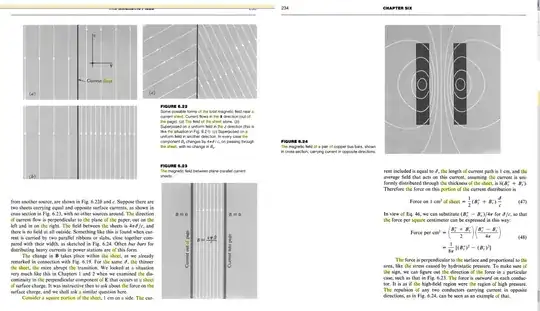I was reading ' Change in B at a current sheet ' in Electricity & Magnetism by Edward M Purcell. this is the concerned excerpt:
Consider a square portion of the sheet, $1~\text{m}$ on a side. The current included is equal to $\mathcal J,$ the length of the current path is $1~\text{m},$ and the average field that acts on this current, assuming that the current is uniformly distributed through the thickness of the sheet, is $\frac{1}{2} ({B_z}^+ + {B_z}^-)\;.$ Therefore the force on this portion of the current distribution is $$\text{Force on $1~\text{m}^2$ of sheet}=\frac{1}{2} ({B_z}^+ + {B_z}^-) \mathcal J$$ ...We can substitute $({B_z}^+ - {B_z}^-)/\mu_0$ for $\mathcal J,$ so that that the force per square meter can be expressed in this way: \begin{align}\text{Force per $\text{m}^2$}&= \left(\frac{{B_z}^+ + {B_z}^-}{2}\right)({B_z}^+ - {B_z}^-)\cdot \frac{1}{\mu_0}\\& =\frac{1}{2\mu_0}[({B_z} ^+)^2- ({B_z}^- )^2]\cdot\end{align} The force is perpendicular to the surface & proportional to the area, like the stress caused by hydrostatic pressure.
I am a bit confused; the magnetic fields ${B_z}^+$ and ${B_z}^-$ are created by the the current in the sheet; how the current itself get affected by the same magnetic field it created? How can the field exert force on the current-carrying sheet as it is itself created by that current?
